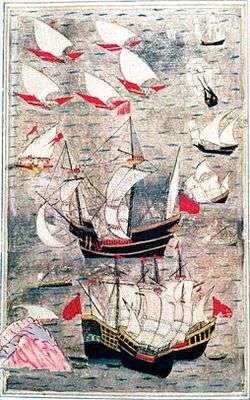Siege of Diu
Coordinates: 20°N 71°E / 20°N 71°E
| First Siege of Diu | |||||||
|---|---|---|---|---|---|---|---|
| Part of Ottoman–Portuguese conflicts (1538–1557) | |||||||
 Ottoman fleet in the Indian Ocean in the 16th century. | |||||||
| |||||||
| Belligerents | |||||||
|
|
| ||||||
| Commanders and leaders | |||||||
|
António da Silveira Martim Afonso de Sousa | Hadım Suleiman Pasha | ||||||
| Strength | |||||||
|
600 men (garrison)[1] 139 ships 186 cannons |
12,000 Gujarati 7,000 Ottomans[2] 72 ships[3] 130 cannons[4] | ||||||
| Casualties and losses | |||||||
| 560+ killed and wounded (garrison)[5] | 3,000 casualties[5] | ||||||
 Siege of Diu (1538) Location within India | |||||||
The Siege of Diu occurred when an Ottoman imperial fleet attempted to capture the Indian city of Diu in 1538, then held by the Portuguese. It ended with a Portuguese victory.
Background
In the Indian Ocean, Hadım Suleiman Pasha, the governor of Ottoman Egypt, led several naval campaigns against the Portuguese in an attempt to remove them and reestablish trade with India. In 1509, the major Battle of Diu (1509) took place between the Portuguese and a joint fleet of the Sultan of Gujarat, the Mamluk Sultanate of Egypt, the Zamorin of Kozhikode with support of the Ottomans. Since 1517, the Ottomans had attempted to combine forces with Gujarat in order to fight the Portuguese away from the Red Sea and in the area of India.[4] Pro-Ottoman forces under Captain Hoca Sefer had been installed by Selman Reis in Diu.[4]
Diu in Gujerat, was with Surat, one of the main points of supply of spices to Ottoman Egypt at that time. However, Portuguese intervention thwarted that trade by controlling the traffic in the Red Sea.[4] In 1530, the Venetians could not obtain any supply of spices through Egypt.[4]
The Ottomans under the Governor of Yemen Mustafa, fought the Portuguese at Aden (1530–31), and sent a fleet to Diu in Gujerat in order to repel a Portuguese siege of the city under Nuno da Cunha. The Portuguese retreated in February 1531.[4]
Soon after however, the Sultan of Gujerat Bahadur Shah, who was under threat from the Mughal emperor Humayun made an agreement with the Portuguese, who took the opportunity to build a strong fort in front of Diu.[4] The Portuguese seized the stronghold of Gogala (Bender-i Türk) near the city,[4] and built the Diu Fort. Once the threat from Humayun was removed, Bahadur tried to negotiate the withdrawal of the Portuguese, but on 13 February 1537 he died drowning during the negotiations on board of a Portuguese ship in unclear circumstances, both sides blaming the other for the tragedy.[6]
Bahadur Shah had also appealed to the Ottomans to expel the Portuguese, which led to the 1538 expedition.[4]
1538 Siege of Diu

The Ottoman governor of Egypt since 1525, Hadım Suleiman Pasha, obtained an agreement from Istanbul to launch an attack against the Portuguese.[4] A fleet of 80 ships, including 17 galleys and 2 galleons, was prepared, and the building of a canal was started between the Nile and Suez in 1531-1532.[4] There were delays however due to the Siege of Coron in the Mediterranean, and the Ottoman-Safavid war of 1533-1535.[4] Meanwhile, the Portuguese continued their progression, and killed Bahadur Shah in February 1537 during a diplomatic encounter on a Portuguese ship (The Gujaratis accuse the Portuguese of having pushed him overboard) .[4]
Aden in Yemen was captured by the Ottomans under Suleiman Pasha in 1538, in order to provide an Ottoman base for raids against Portuguese possessions on the western coast of India.[4][7] The Sultan of Aden, Sheikh Amir bin Dawaud, an ally of the Portuguese, was hanged when he was invited on the Ottoman ships, and the city was captured without a siege.[4]
The Ottoman fleet, consisting of 72 ships,[3] left Aden on 19 August 1538 and arrived at Diu on 4 September 1538.[4] It was the largest Ottoman fleet ever sent into the Indian Ocean.[3][8] The Ottoman fleet laid siege to Diu with 130 cannons and bombarded the city.[4] Soon however, news were received of the arrival of a strong Portuguese relief fleet. At the same time, it seems that the new ruler of Gujerat was weary of Ottoman control, and did not support them adequately during the siege.[4] The Ottomans finally had to lift the siege.[4]
Aftermath
After the failed siege, the Ottomans returned to Aden, where they fortified the city with 100 pieces of artillery.[7][9] One of them is still visible today at the Tower of London, following the capture of Aden by British forces in 1839.[10] Suleiman Pasha also established Ottoman suzerainty over Shihr and Zabid, and reorganized the territories of Yemen and Aden as an Ottoman province, or Beylerbeylik.[4]

Suleiman Pasha intended to launch a second expedition against the Portuguese in Diu, but this did not happen.[4] In 1540, the Portuguese sent a retaliatory expedition to the Red Sea, attacking Suakin and Kusayr, and attempted to take Suez with a fleet of 72 ships in 1541.[4][11] In 1546, the Ottoman established a new naval base in Basra, thus threatening the Portuguese in Hormuz.[4] The Ottomans would suffer a strong naval defeat against the Portuguese in the Persian Gulf in 1554.[4] Further conflict between the Ottomans and the Portuguese would lead to the Ottoman expedition to Aceh in 1565.
The Indians would not retake possession of the Diu enclave until Operation Vijay in 1961.[12]
Gallery
-

The Diu Fort was built by the Portuguese in 1535.
-

Aden cannon of Hadım Suleiman Pasha, founded by Mohammed ibn Hamza in 1530–31 for an Ottoman invasion of India. Taken in the capture of Aden in 1839 by Cap. H. Smith of HMS Volage. Tower of London.
-

Flag of the Siddis from Murud-Janjira an important vassal of the Mughal Empire and a crucial ally of the Ottoman Navy.
-

The siege of Diu by the "Arabians"
-

Map of Diu, 1729.
See also
Notes
- ↑ Asiatic Society of Bombay: Journal of the Asiatic Society of Bombay (Edition 25), The Society, 1922, page 316.
- ↑ Sophus Ruge: Geschichte des Zeitalters der Entdeckungen, G. Grote, 1881, page 195. (German)
- 1 2 3 European warfare, 1494-1660, Jeremy Black pg 60, 2002, ISBN 0415275326
- 1 2 3 4 5 6 7 8 9 10 11 12 13 14 15 16 17 18 19 20 21 22 23 24 An economic and social history of the Ottoman Empire by Halil İnalcik p.324ff
- 1 2 Churchill: A Collection of Voyages and Travels: Some Now First Printed from Original Manuscripts, Awnsham and John Churchill, 1704, page 594.
- 1 2 The Cambridge history of the British Empire, Volume 2 by Arthur Percival Newton p.14
- 1 2 The history of Aden, 1839-72 by Zaka Hanna Kour p.2
- ↑ Nicola Melis, "The chronicle of Lopo de Sousa Coutinho as a major source of the first siege of Diu", in "The Indian Ocean and the Presence of the Ottoman Navy in the 16th and 17th Centuries", edited by Naval Forces Staff, Naval Printing House, Istanbul 2009, part III, pp. 15-25.
- ↑ An economic and social history of the Ottoman Empire by Halil İnalcik p.326
- ↑ Tower of London exhibit
- ↑ Mecca: a literary history of the Muslim Holy Land by Francis E. Peters p.405
- ↑ McGregor, Andrew James A military history of modern Egypt: from the Ottoman Conquest to the Ramadan War; p. 30